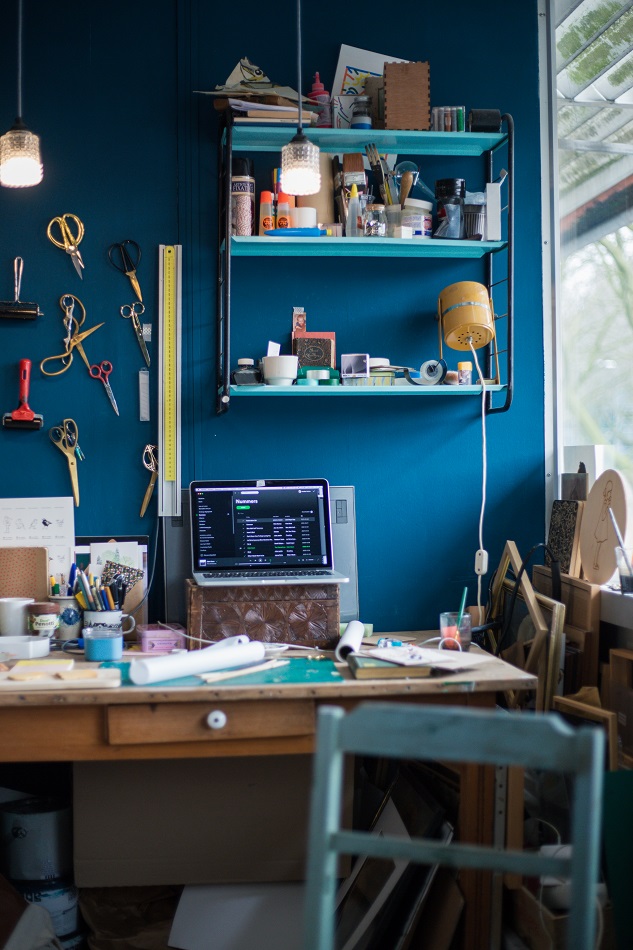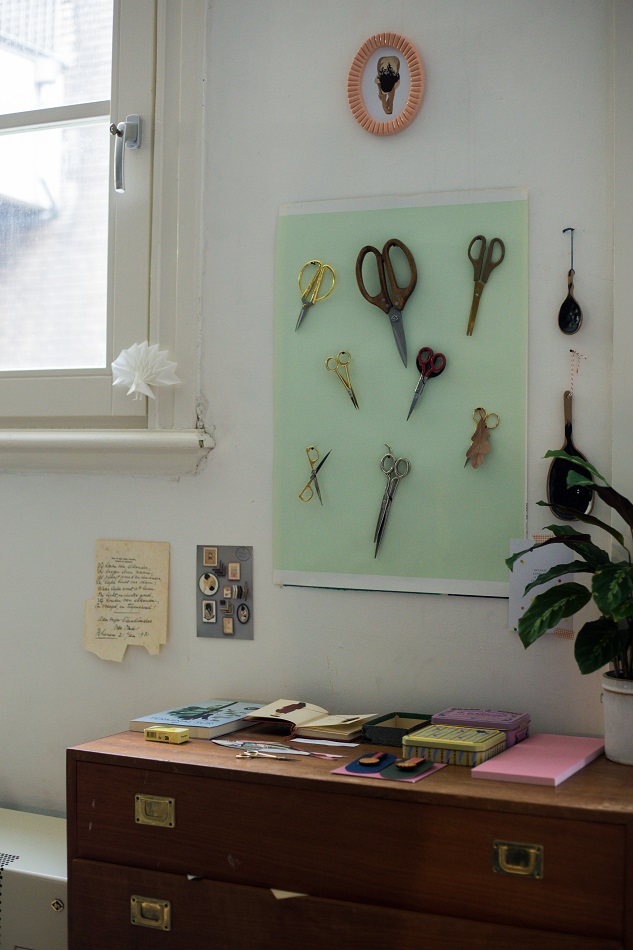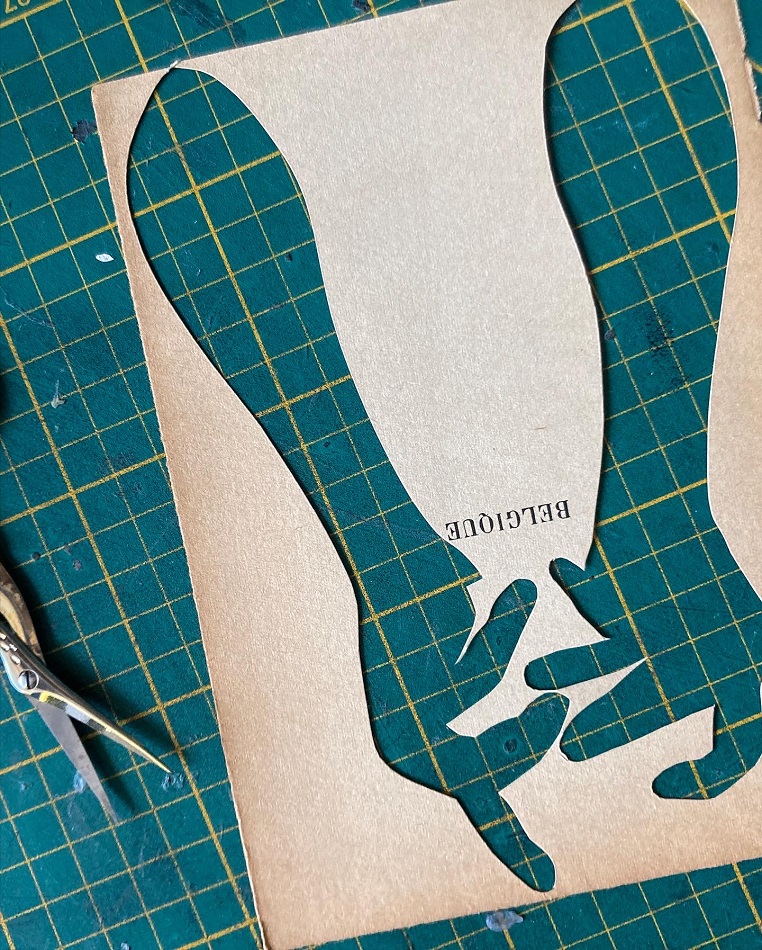Danièle Knirim

Danièle Knirim is a collage artist living and working in The Hague under the name Hiervandaan; a play on words literally translated as ‘from here’ but also referring to her nickname Daan. Her striking work features portraits of women, anonymous figures and beautifully pieced-together birds. Although instantly recognisable, her collages of romantic scenes and melancholic figures lean toward abstract representation. Danièle tells me, “I like to let the viewer figure out what they see”. She was once advised not to use the word ‘collage’ for her work but rather papier decoupé. According to that person, the term from the tradition of Matisse surely sounded much better and professional, didn’t it? Daan tells me this in her friendly and no-nonsense manner. She only started making collages relatively recently in 2018, and is down to earth about her work, she describes her time at the studio simply as ‘cutting and pasting’.

The first time I meet Daan is at her former studio in Mariahoeve, a suburb of The Hague, a tiny room in an old office complex accommodating a small community of creatives. Each unit has its particular character, and as Daan invites me in, I feel like I have stepped into another world. This space is small. It's tiny. A desk, a very small table, bookshelves along the full breadth of the tiny corridor, and a small bench. Of course, there is paper everywhere. The walls hold her work, her tools, and the shelves have all sorts of nick-knacks arranged thoughtfully. It is like entering the wardrobe in C. S. Lewis’s The Lion, the Witch and the Wardrobe, but instead of walking into a winter wonderland, you step into a paper heaven where everything has its place. There is a sense of careful curation despite piles of paper, a sense of order and peace. Daan knows where everything is; this space has seen her through five years of work as a self-employed artist. Since we met for the interview, Daan has moved to a bigger studio with more room, natural light, and the added social element of sharing studio space. This new studio invites a different work set-up, with multiple desks and tables and more room to try out bigger work. It feels like the move reflects the next step in claiming her space in a literal and figurative sense.

Her primary school education at a Jenaplan school was an educational form which encouraged project-based autonomous work and a level of independence from a young age. “It taught me to stand strong and speak out. After secondary school, which I found a bit boring to be honest, I went to an open day at Nimeto, a vocational school for creative space makers in the city of Utrecht. That’s when I decided to apply for the (Allround) Stand & Decor builder course. It was a tough entrance exam, but I really wanted it, and I got in and completed a very practical hands-on study. I remember if something wasn’t made according to the instruction it was dismissed or tossed in the rubbish and we would start again. I learnt how to construct things and learned about perspective and working neatly and it was all analogue. The study was tough, but I still benefit from what I learned there today.
"There was and still is a sense of wonder of seeing a piece that clicks in place. It’s like a revelation to see that I made a piece of work that came entirely from within me.”
It wasn't until I attended the Willem de Kooning Academy in Rotterdam that I started to enjoy being a student. That’s where I studied illustration because I thought I was a good drawer. My mother is an artist working in oil painting and sculptures. I was also told that I was good at painting, but I had decided that I could differentiate myself with my collage work. My painting style wasn't unique, but I thought my decoupage works could stand out. And more importantly, I got great enjoyment from looking for the right paper and puzzling the pieces together. There was and still is a sense of wonder of seeing a piece that clicks in place. It’s like a revelation to see that I made a piece of work that came entirely from within me.”
“For many years, I worked for a stop-motion animation studio where we had many big-name clients. We worked on big corporate branding projects, and it was a stressful environment.” Her tireless work ethic and focus on delivering flawless work left no room for her creative expression, and she describes coming out of the relationship as coming up for air. “I think my focus was everywhere but on my own dreams, which were drowning in the process.”
“Later, at an exhibition of my work, a Japanese visitor asked me, out of the blue, if I had experience in stop motion/animation. I was surprised by his comment, but he was right, of course. His opinion was based on the observation that I had an eye for choosing the exact moment to capture and replicate in a collage. It was an Aha! moment for me, as I realised that my experience in stop motion had trickled into this craft. When I consider all those hours that I committed to making 24 frames per second… All that work to capture the exact image for each movement. It’s clear now that I use that experience in my analogue art.”
"When I pick up a book in a thrift shop and turn the pages, I immediately see future body parts, a freckled cheek or the skin of the neck."
Danièle also has a part-time job at a reputable frame-makers in The Hague. “Working at the frame-makers, I appreciate the social aspect of having colleagues and how nice it is to have people who greet you when you walk in to work and are happy to see you. Some specific tasks need the utmost precision, and it’s clear to see how much my further education does come in handy now. But I also enjoy working with tools and the hands-on element of crafting the frames.”
Precision work
Once she started cutting paper and constructing her bird collages, she couldn't stop and made several series of works in relatively quick succession. “My weekends are free to fill as I please, and I love going to the studio at the weekend and working in the quiet calm of a Saturday or Sunday morning.”

The birds, which have become signature works, are built from layers of cut-out elements intricately and patiently layered to become a woodpecker, a robin, or a starling. These are not simply copied from a reference book, Danièle is a dedicated ornithologist and proudly tells me that her interest in birds took off when she was a member of the birdwatching club at school. She strives to make the bird collages as realistic as possible, starting with photos as reference but by now she is quite an expert in detailed features of the different birds. Considering this and her eye for detail, experience in graphic design, and quiet, confident skill in cutting and working with paper, it is no surprise that her unique work is popular.
Reading paper colours as shades of skin tone
“I’m always looking for old paper for my work, the more weathered and discoloured the better. Old books are perfect, especially the front pages, even if they might be stained by foxing, water stains, or light discolouration. Some old books have these beautifully patterned pieces of paper, which are my favourite for the clothing in a portrait or a specific bird part. When I pick up a book in a thrift shop and turn the pages, I immediately see future body parts, a freckled cheek or the skin of the neck. I can already identify pages destined for body parts or bird parts. For the larger pieces of work, I use atlases. I have a collection of atlases missing the first and last pages!
"I completed the series and realised I had collaged the process of peeling off layers, discarding unwanted baggage and returning to myself after a break-up."
I tend only to use old and cheap books found at the weekly book market on Thursday in the city centre. Or I go to my regular thrift store and see if they have fresh finds. Friends or acquaintances often gift me paper, and as much as I appreciate the kindness, the bit where I go hunting for paper is one of my favourite parts of my work. I love visiting the thrift store and have one nearby that is great for restocking my source material library. When abroad on holiday, I often visit bookshops and second-hand shops to see what treasures I might find.”

The paradox of contentment and longing
After the initial bird collages, the first series was ‘Undressed’ and came from observations and personal experience in the changing rooms of the swimming pool. “You know, that awkwardness of undressing in a confined changing room? And the fight you have getting undressed and peeling off a wet swimsuit. I wanted to capture that moment and started cutting body parts in unusual angles, keeping the figures' faces hidden so that the viewer could perhaps identify with them. I completed the series and realised I had collaged the process of peeling off layers, discarding unwanted baggage and returning to myself after a break-up.”

The following series, ‘Unseen’, continued to reflect her emotional state at the time, with figures mostly hidden behind a tree or a book. The images were collage interpretations of Daan’s desire to hide from the world. “I just wanted to disappear”. The combination of pencil drawing and cut-out elements differed from her previous collages. The human figure was always constructed with collage, often based on a photograph of Daan herself. “I eliminate details from an image to hint at something and let the viewer figure it out. I also use photos of myself because, well, that’s what is always available. And inevitably, I realised there was no need to hide from myself. All you want and all your strength is right there inside you.”
A chapter of highs and lows followed, captured in ambiguous collages of feet and limbs suspended in mid-air. Looking at these, it’s not clear if this split second is someone falling to the ground or jumping for joy, and that questionable element is exactly what Danièle hoped to achieve. Aside from catching more movement, she also made a transition to producing work on a bigger scale. Some of the pieces in ‘Falling and Jumping’ measure 50 x 70 cm. “I wanted to use everything available and get the most out of my paper”.

“It’s special to work on commission, and delivering an assignment for a client is very much about applying myself, translating the clients' message into my style and being disciplined to get it done on time. But if I’ve been walking around with an idea for a new piece, I might start working on two pieces simultaneously. I want to see what works best and catch the ideas that are coming in fast. So when I can have the time and space to dive into that, it’s a great and satisfying feeling.”
This article was featured in issue 23 of Contemporary Collage Magazine.
Photos by @gingerandthewolf ©